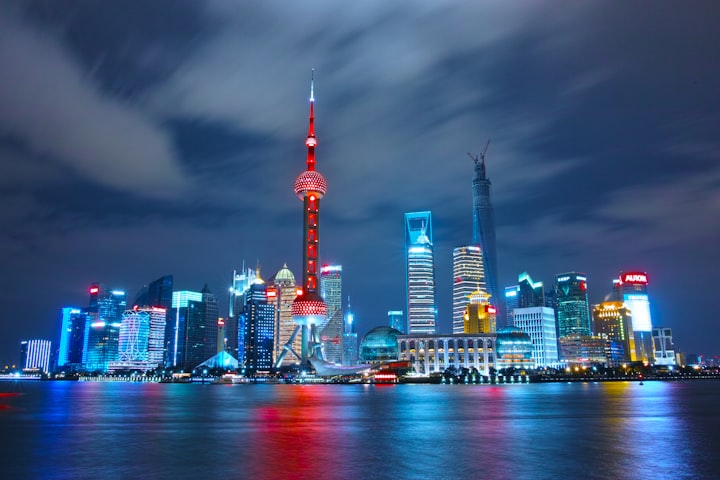A Boatman, A Bridge And A High Speed Train
The New Silk Road
In the spring of 2018, my partner and I traveled to Asia.
Near the middle of our trip, we met friends in Laos. Together we explored the country, from the southern city of Vientiane to Luang Prabang in the north.
One morning after breakfast, we crossed the small river near our hotel using a bamboo footbridge. We walked through the town and made our way to the Mekong River. There were wide concrete steps leading down to a collection of colorful riverboats, arranged in a line.
The Mekong is the twelfth longest river in the world. It flows from the Tibetan Plateau through Laos to Cambodia, then across the southernmost tip of Vietnam, emptying into the South China Sea.
We watched fishermen bringing their catch to restaurants, families traveling with school-aged children, and boatmen available to ferry goods to the other side.
It was there that we met Phet, the boatman.
Phet brought us down to the shore and showed us where his longboat was moored with a long rope and an anchor dug into the sand.
The boat was long and skinny, with a passenger cabin that had two seats across, a narrow aisle up the middle, and a roof for shade. There was a separate section in the front for the driver. Phet and his wife lived in a small cabin at the rear. The boat was painted in a rainbow of blues, red and yellow.
We talked to Phet about going on a river tour, but we’d seen many of the traditional tourist places so we wanted something different. After some discussion, we settled on a trip to a pottery village, and a remote traditional village upriver.
It cost 50,000 Kip per person- about $5 US.
The river was wide and muddy and slow-moving. You could see the current roiling just under the surface. As we journeyed upriver, we passed villages and many boats that looked like they were also liveaboards. We arrived at the traditional village, and he landed us on the edge of a low sandy shore.
Clambering up the bank, we found ourselves on a short wide dirt path that wound through a collection of houses. There might have been ten houses there, maybe 50 people in the whole village. The homes were mainly built with bamboo and woven reeds and we could see seaweed drying on racks in the yard. The roofs were mainly corrugated sheet metal.
Phet spoke with a local and they invited us into their home. There were two main rooms, very dimly lit by the sunshine coming through the doorway. They had limited electricity and proudly showed us their television blaring in the corner.
The inner walls were lined with stacked bags of rice. The owner told us (through Phet) it was the food for the family for a year. This tiny village also supported a temple (Wat) with 3 monks.
We heard a chorus of shrieking laughter and found young children playing in the path. Two boys were racing little homemade go carts down an incline, screaming with delight as their sister watched. The go cart wheels were made of spools that industrial wire comes wrapped around. One came off and we helped him replace the cotter pin.

When we reached the top of the village, I was surprised to see a newly built rough gravel road. The villagers told us it was built by the Chinese and it was a haul road for the dump trucks.
After we asked more questions, they took us back down to the river and in the distance, we could see immense concrete pillars under construction.
"It was a bridge," they said, "for the train."
China is building a high speed train through Laos.
When I returned home, I researched the project. It’s being built by the Laos-China Railway Co, and much of it is likely finished by now. What we saw was the first of two bridges that will span the Mekong River. The span we saw was 1458 meters long, crossing a wide part of the river.
The high speed train originates in China, crosses the Mohan-Boten border in northern Laos where it follows the Mekong down to a point near Vientiane. There it travels west into Thailand and follows the peninsula south through Malaysia into Singapore.
It covers 414 Km.
The route is designed for a train speed of 160 km per hour. The railway is expected to be fully operation in December 2021.
They call it the new Silk Road.
As we stood there on the side of a riverbank with the traditional village behind us, we were surprised, upset, and impressed all at once.
It was unexpected to see such a juxtaposition of modernity and tradition.
The lives of the villagers are changing forever. All of the people on the route will be impacted by access and traffic. There will be benefits from increased access to jobs.
One local engineer was thankful that he had access to the modern training that was provided on the project.
He’s teaching his children to speak Mandarin.
If you'd like to connect, find me on Twitter, Wordpress, and Quora.
If you enjoyed this story, send me a tip so I can write another one.
Or share it on social media. Your recognition means a lot to me.
This story also appears on Medium by Tree Langdon, the author.
About the Creator
Tree Langdon
Get an idea, a new word and a question.
For more, read my bio here.







Comments
There are no comments for this story
Be the first to respond and start the conversation.